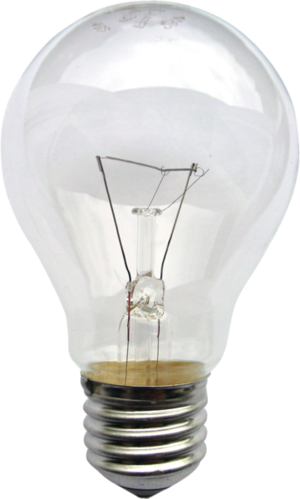Incandescent light bulb
Incandescent light bulbs are devices that convert electricity into light by heating a filament using electrical current until it emits electromagnetic radiation. As current passes through the filament, its high resistance causes its temperature to rise until it glows. This effect is known as incandescence, and it is the guiding principle behind the traditional light bulb (see figure 1). The light bulb filament about 3000 K, so it gives off blackbody radiation, which (as shown below) means a lot of energy is going into heat.
Although this method of lighting is still remarkably widespread, numerous alternatives are growing more popular due to the extreme inefficiency of incandescent bulbs as they only convert about 10% of the electrical energy they receive into visible light, with the rest being dissipated as heat.[1] In Canada, legislation has been place since 2014 to phase out incandescent bulbs with alternatives like halogen lights, CFL light bulbs, and LED light bulbs.[2]
Phet Simulation
The University of Colorado has graciously allowed us to use the following Phet simulation. Explore this simulation to see changing temperature changes the amount of radiation given by a light bulb filament. Note that much of the energy is coming off as heat:
References
- ↑ Edison Tech Center. Incandescent Lamps [Online}. Available: http://www.edisontechcenter.org/incandescent.html
- ↑ Natural Resources Canada. Canada’s standard for efficient light bulbs [Online]. Available: https://www.nrcan.gc.ca/energy/products/whats-new/13583


